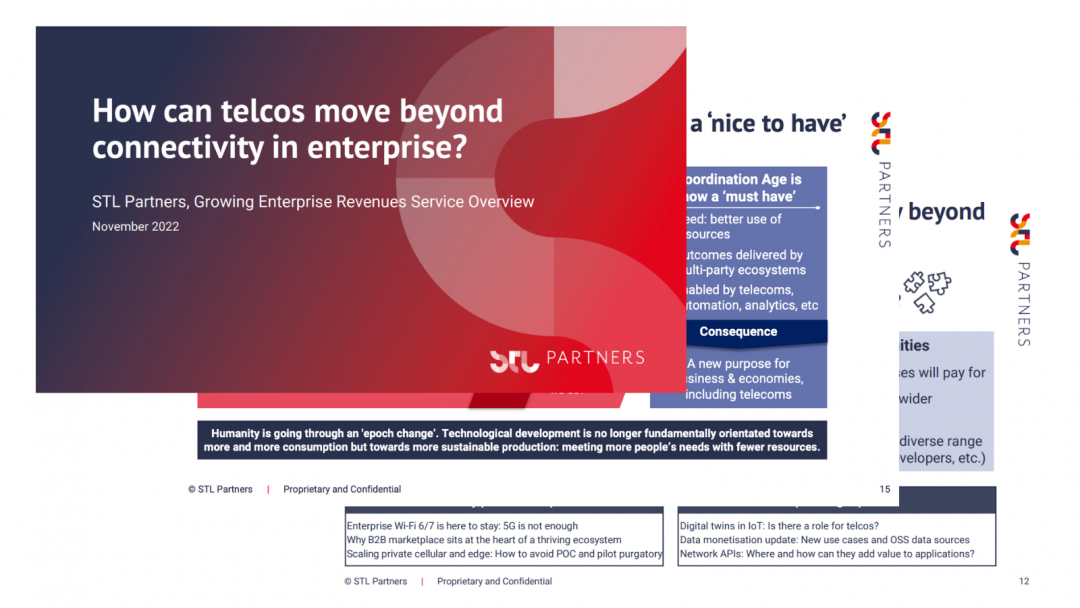
Network intelligence and the emergence of the NSAPs
STL Partners conducted research, supported by Altran, into the emergence of a new category of services that are increasingly important to enable the next generation of network dependent services. In this article, we detail our findings.
There is a resurgent interest in applications interfacing with networks
With the advent of 5G, NFV and cloud native networking technologies there is a clear and growing need for greater ‘network intelligence’ amongst applications and platforms. The network is moving away from being a black box that application providers need to engineer around, and a more dynamic relationship is emerging between the network and the application.
Dynamic network slicing, for instance, needs to be able to scale up and down depending on needs.
- IoT is increasingly being used for more mission critical use cases and having network awareness can enhance reliability and performance.
- Network virtualisation means that networks are becoming increasingly programmable.
- Automation, advanced analytics, and AI bring enhanced capabilities in configuring, operating and managing networks.
- Edge computing requires distributed workloads to achieve lower latency and bring compute closer to the applications.
- Identifying best network locations to place edge computing nodes also requires a high level of network insight.
In all of these domains, network intelligence is either a fundamental part of the application proposition, or is a way to improve the proposition.
An example of a scenario where network intelligence and awareness would be required is in connected cars, where multiple applications are simultaneously running and competing for network resources. Automotive applications that rely on services such as firmware updates or V2X communications to support autonomous driving or to provide infotainment platforms need to be more aware of, and able to act on connectivity issues around bandwidth, latency and the overall quality of connection. With tools to expose greater visibility and predictability around network performance, these applications can optimise their own performance accordingly to deliver enhanced outcomes and customer experiences.
A new category of players: Network Software Application Providers (NSAPs)
Altran, a global engineering firm, asked STL Partners to research the emergence of application providers that have an increasing interest in making their applications more integrated with the networks. Altran calls this category of service providers ‘Network Software Application Providers’ or NSAPs.
Our research established that there is an existing market of these application providers who have more network awareness and network intelligence. There were certain domains where NSAPs were particularly relevant, such as connected car, edge computing, IoT and service assurance.
What classifies as an NSAP?
Altran and STL Partners classify network intelligence as the ability to collect and act on information about the state of the network. Through this research we identified three levels of ‘network intelligence’: aware, intelligent, and orchestrating. NSAPs are those that offer either one or a combination of these services through their software solutions and services.
Figure 1 below maps how these levels relate and can be distinguished from one another.
- Network aware services collect simple data about the state of the network (availability or condition) and execute a simple, automated response, such as reporting, and/or analysis, or connect ‘Yes/No’.
- Network intelligent services collect rich data about the state of the network (e.g. performance/routing/topology via APIs/middleware) and automatically optimise cloud resources.
- Network orchestrating services collect rich data about the state of the network (within network or via APIs/middleware) and automatically orchestrate network resources.
Note: software using data via public APIs (e.g. billing, identity, location) are not considered ‘intelligent’
Figure 1: Three levels of NSAP intelligence

Source: STL Partners
NSAPs are heterogenous and therefore have different needs and requirements
Altran also identified three categories of NSAPs based on where they sit in the value chain, and to what end they are being used. They are
- Vertical application developers (VADs);
- Enterprise communication enablers (ECEs);
- Network component developers (NCDs).
VADs are application-based, vertical-specific (software) services to enterprises. They leverage network data to improve enterprise outcomes by optimising enterprise resource configuration (in a simple way).
An example of a VAD is NVIDIA’s cloud gaming service GeForce NOW, which works with CSPs to enable dynamic workload allocation across edge computing nodes. IIoT and fleet management company Samsara also classifies as a VAD. Its solutions have local storage capabilities that can support a local network if internet connectivity becomes unavailable. Devices can switch to this local alternative based on the network performance. They have an agreement with operators to ensure 99% uptime.
ECEs are platform-centric, with an emphasis on supporting application developers. They are highly automated and integrated with the network, providing scalability and flexibility. They use network data to optimise enterprise and/or network resource configuration in a way beneficial to the enterprise.
IoT platform provider Particle is a good example. Their service offers carrier switching based on signal strength and possibly also cost. Intel’s Smart Edge division, which offers a multi-access edge platform for on-premise enterprise deployments, is another example. It is an ECE in that it is platform-centric and its MEC appliance responds to network and application performance data.
NCDs are highly embedded in the network. They focus on orchestrating the network to increase efficiency, increase performance or enable the creation of new services.
B-Yond is one example: it is providing network intelligence capabilities to CSPs through AI and automation solutions.
Figure 2: The three flavours of NSAPs

Source: STL Partners, Altran
The NSAP opportunity is significant and growing
Vertical industries are increasingly spending on IT and communications, of which a significant proportion is estimated to go towards network software applications.
Our modelling estimates that of the total industry spend on network software applications, around £13bn could be addressed by NSAPs in 2020.
We believe that this number will grow significantly in the coming years. Of the companies that we profiled in the NSAP category, many were only scratching the surface when it came to their network intelligence. There is a large untapped potential for application providers to improve their network intelligence. There are many ‘OTT’ software providers, for instance, that play in the same space as NSAPs, but are not currently network aware or intelligent. We believe this is something that will be required of these providers as new services are developed and we move into the third age of telecoms: the Coordination Age.
What does this mean for telcos?
There is a clear role for telcos to play in driving this trend. Telecommunications still dominate the global industry network software application spend on network functionality, as shown in Figure 3. STL Partners estimates that the telecommunications industry accounts for 46% of this spend globally.
Figure 3: Spend on network software applications by industry

Source: STL Partners
Telcos can provide value to application providers by opening up their networks, enabling applications providers to extract more and potentially richer network insights through APIs.
In our conversations with telcos, we have seen increasing and genuine interest in pursuing this opportunity. In the past, most API programmes have primarily focused on the BSS domain (e.g. billing, trouble ticketing), but now there is a desire for more API exposure for network functions. However, there remain a number of challenges, and few telcos can fully articulate this API-enablement vision. Many telco B2B teams are not as concerned about the cloud native plumbing required to deliver this as technology teams, and while technology teams understand the potential and the innovation angle, they lack the commercial impetus from within the organisation to deliver it. We will be covering this in detail in forthcoming reports.
Find out more about our research on our research hub.
Download this article as a PDF
Read more about growing enterprise revenues
Growing Enterprise Revenues overview pack
Our overview pack explores how the telecoms industry can leverage new business models to meet enterprise customer needs
5G for business: An update on telco pioneers
SK Telecom, Verizon & Telstra have looked to expand their 5G networks & to provide businesses with more opportunities to take advantage of 5G
5 innovative telehealth apps for 2022
Demand for telehealth apps has been increasing rapidly in recent years as healthcare continues its move towards digitisation, with COVID-19 only accelerating this trend. 2020 alone saw 90,000 new telehealth apps added to the market, so finding a niche is crucial. Below we outline 5 telehealth apps which exemplify different potential niches in the market.
Vonage: What is Ericsson’s end game?
If Ericsson is able to successfully leverage Vonage’s developer ecosystem to drive the use of 4G and 5G APIs, then it could play an interesting role as a strategic partner and channel for operators as a means of accessing developer communities.





